BSBCOM603: Assessment of Compliance Management System for Charity Care
VerifiedAdded on 2023/01/05
|18
|4294
|89
Report
AI Summary
This report provides an in-depth assessment of the compliance management system for Charity Care, a not-for-profit organization. It begins with an executive summary outlining the report's objectives, which include analyzing Charity Care's compliance requirements, encompassing internal, industry-specific, and external regulations. The report details these requirements, identifies areas of the organization most affected by them, and presents organizational compliance data. It also addresses the risks associated with non-compliance, potential penalties for breaches, and strategies for ensuring ongoing compliance. Furthermore, the report outlines available compliance management system options, compares them, and offers recommendations. A significant portion of the report is dedicated to a research plan, detailing the type of research, research tasks, development of survey tools, and data analysis methods employed to evaluate Charity Care's compliance performance. The report concludes with an analysis of the organization's compliance performance data and a summary of key findings.
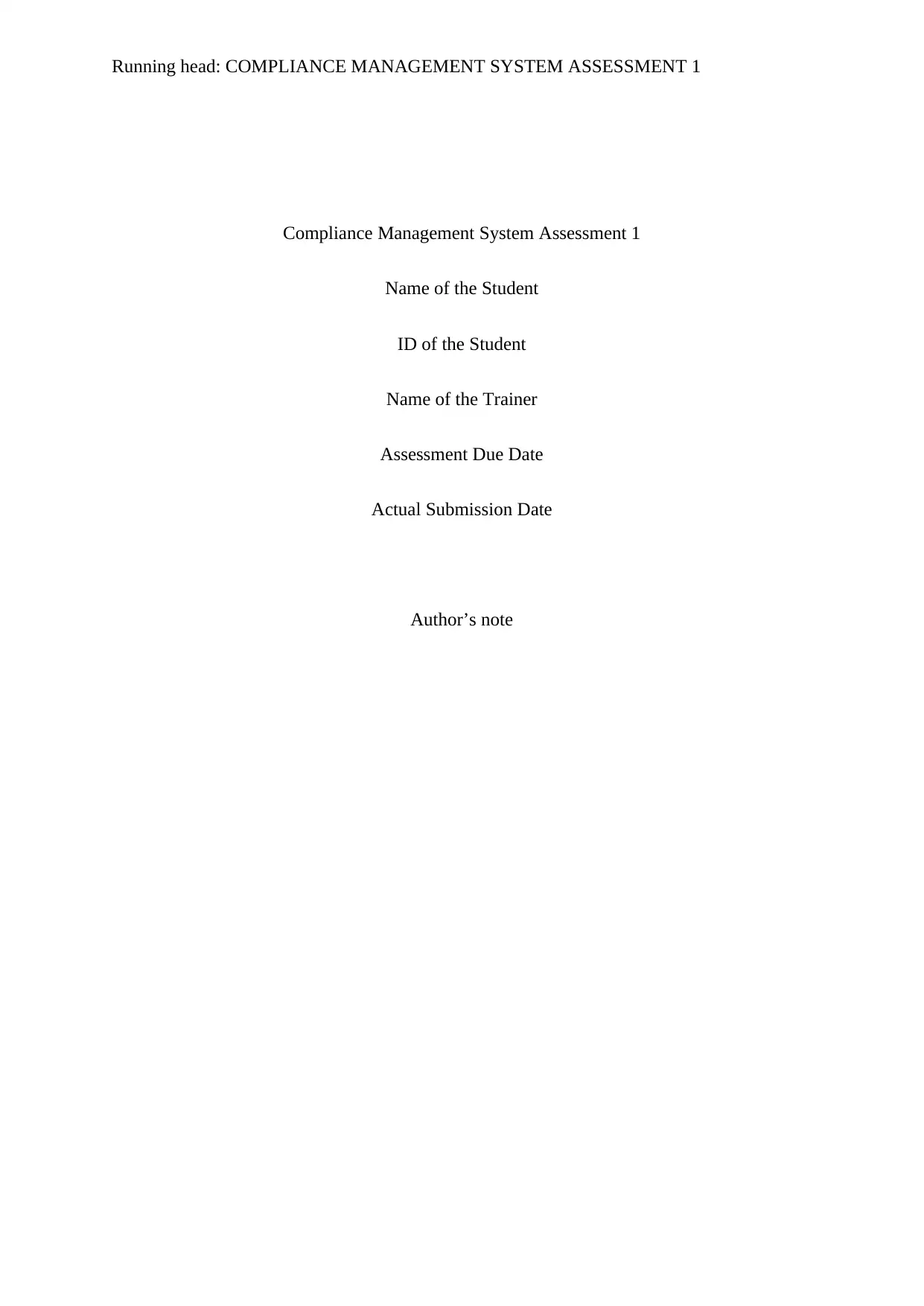
Running head: COMPLIANCE MANAGEMENT SYSTEM ASSESSMENT 1
Compliance Management System Assessment 1
Name of the Student
ID of the Student
Name of the Trainer
Assessment Due Date
Actual Submission Date
Author’s note
Compliance Management System Assessment 1
Name of the Student
ID of the Student
Name of the Trainer
Assessment Due Date
Actual Submission Date
Author’s note
Paraphrase This Document
Need a fresh take? Get an instant paraphrase of this document with our AI Paraphraser
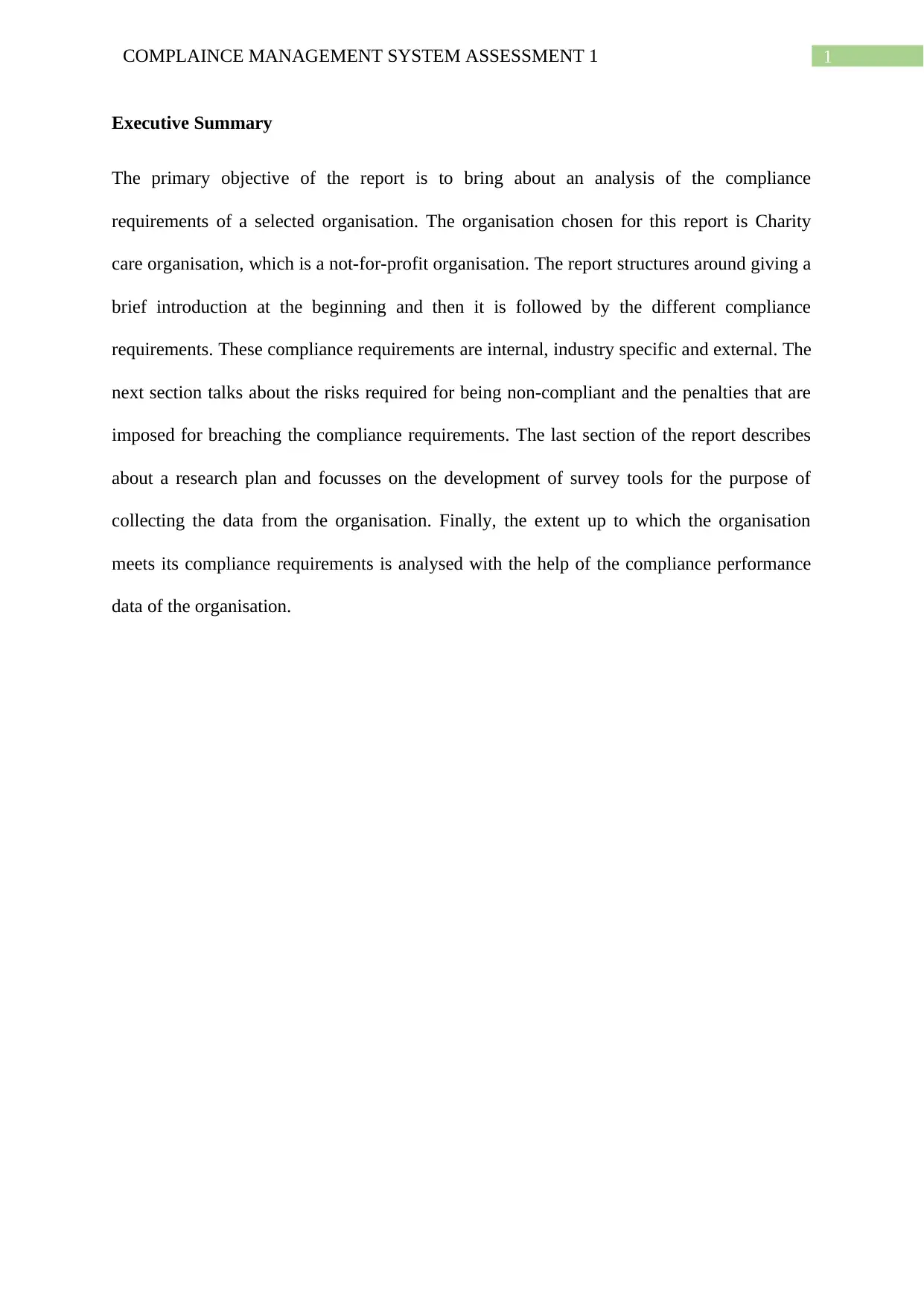
1COMPLAINCE MANAGEMENT SYSTEM ASSESSMENT 1
Executive Summary
The primary objective of the report is to bring about an analysis of the compliance
requirements of a selected organisation. The organisation chosen for this report is Charity
care organisation, which is a not-for-profit organisation. The report structures around giving a
brief introduction at the beginning and then it is followed by the different compliance
requirements. These compliance requirements are internal, industry specific and external. The
next section talks about the risks required for being non-compliant and the penalties that are
imposed for breaching the compliance requirements. The last section of the report describes
about a research plan and focusses on the development of survey tools for the purpose of
collecting the data from the organisation. Finally, the extent up to which the organisation
meets its compliance requirements is analysed with the help of the compliance performance
data of the organisation.
Executive Summary
The primary objective of the report is to bring about an analysis of the compliance
requirements of a selected organisation. The organisation chosen for this report is Charity
care organisation, which is a not-for-profit organisation. The report structures around giving a
brief introduction at the beginning and then it is followed by the different compliance
requirements. These compliance requirements are internal, industry specific and external. The
next section talks about the risks required for being non-compliant and the penalties that are
imposed for breaching the compliance requirements. The last section of the report describes
about a research plan and focusses on the development of survey tools for the purpose of
collecting the data from the organisation. Finally, the extent up to which the organisation
meets its compliance requirements is analysed with the help of the compliance performance
data of the organisation.
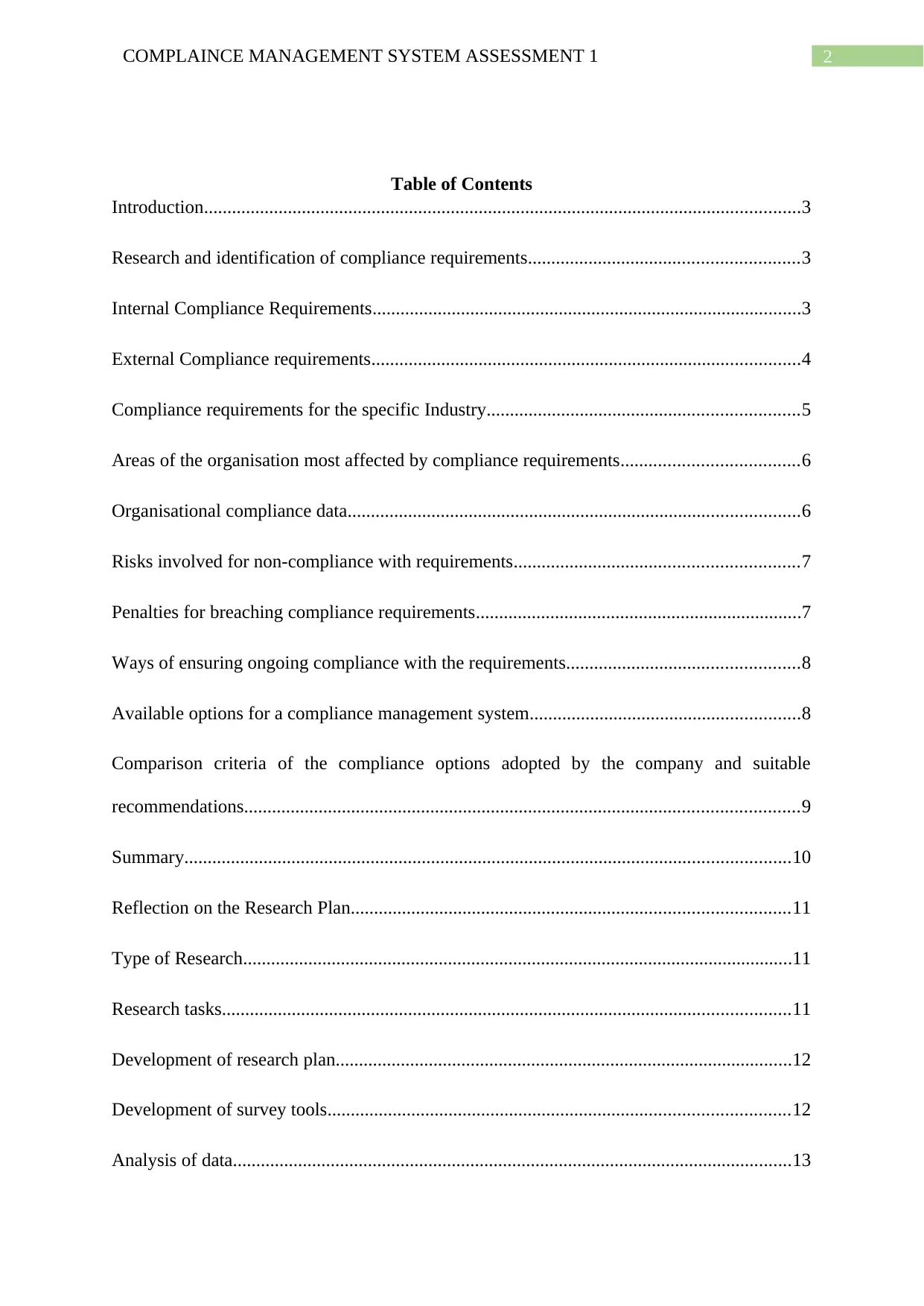
2COMPLAINCE MANAGEMENT SYSTEM ASSESSMENT 1
Table of Contents
Introduction................................................................................................................................3
Research and identification of compliance requirements..........................................................3
Internal Compliance Requirements............................................................................................3
External Compliance requirements............................................................................................4
Compliance requirements for the specific Industry...................................................................5
Areas of the organisation most affected by compliance requirements......................................6
Organisational compliance data.................................................................................................6
Risks involved for non-compliance with requirements.............................................................7
Penalties for breaching compliance requirements......................................................................7
Ways of ensuring ongoing compliance with the requirements..................................................8
Available options for a compliance management system..........................................................8
Comparison criteria of the compliance options adopted by the company and suitable
recommendations.......................................................................................................................9
Summary..................................................................................................................................10
Reflection on the Research Plan..............................................................................................11
Type of Research......................................................................................................................11
Research tasks..........................................................................................................................11
Development of research plan..................................................................................................12
Development of survey tools...................................................................................................12
Analysis of data........................................................................................................................13
Table of Contents
Introduction................................................................................................................................3
Research and identification of compliance requirements..........................................................3
Internal Compliance Requirements............................................................................................3
External Compliance requirements............................................................................................4
Compliance requirements for the specific Industry...................................................................5
Areas of the organisation most affected by compliance requirements......................................6
Organisational compliance data.................................................................................................6
Risks involved for non-compliance with requirements.............................................................7
Penalties for breaching compliance requirements......................................................................7
Ways of ensuring ongoing compliance with the requirements..................................................8
Available options for a compliance management system..........................................................8
Comparison criteria of the compliance options adopted by the company and suitable
recommendations.......................................................................................................................9
Summary..................................................................................................................................10
Reflection on the Research Plan..............................................................................................11
Type of Research......................................................................................................................11
Research tasks..........................................................................................................................11
Development of research plan..................................................................................................12
Development of survey tools...................................................................................................12
Analysis of data........................................................................................................................13
⊘ This is a preview!⊘
Do you want full access?
Subscribe today to unlock all pages.

Trusted by 1+ million students worldwide
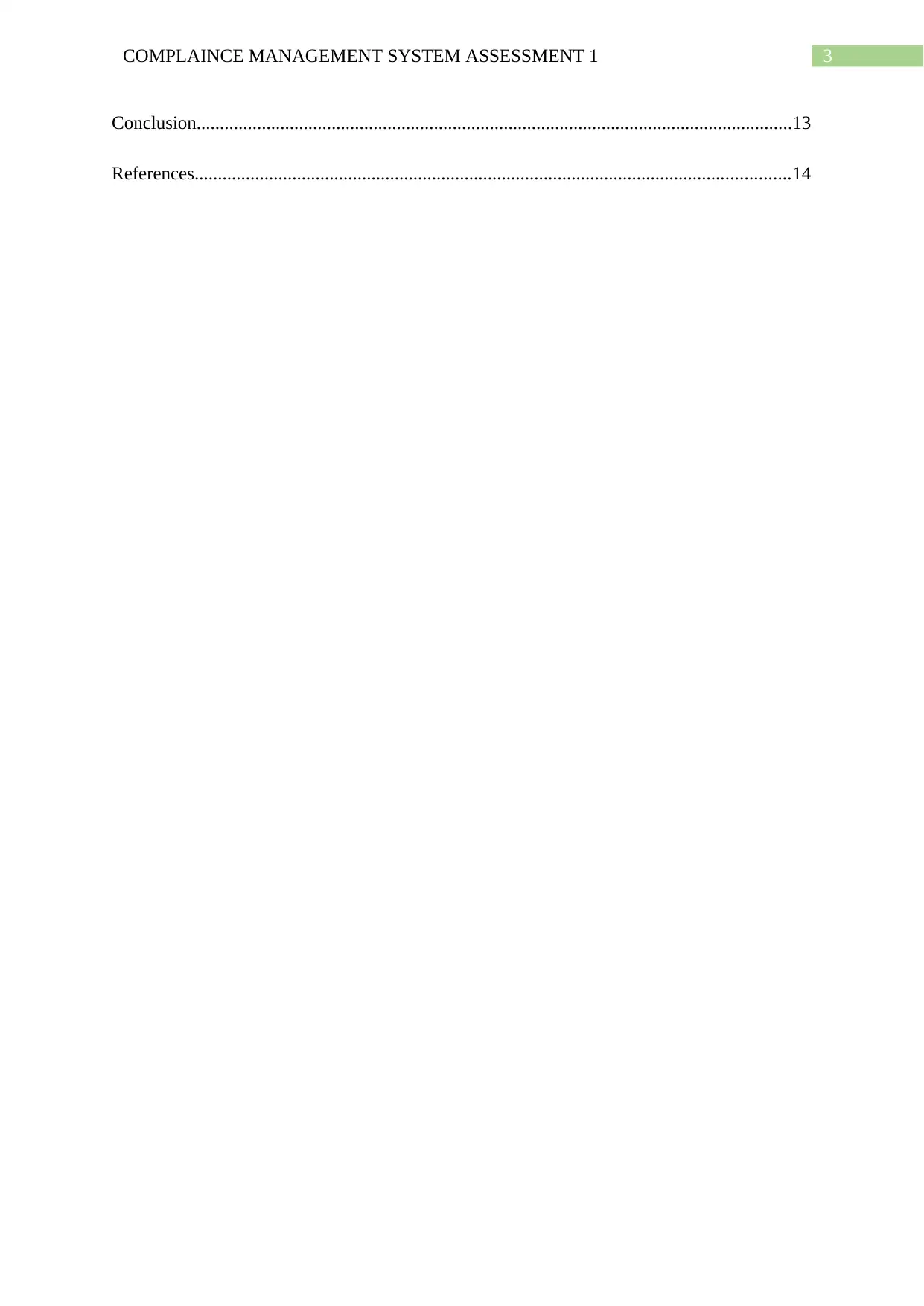
3COMPLAINCE MANAGEMENT SYSTEM ASSESSMENT 1
Conclusion................................................................................................................................13
References................................................................................................................................14
Conclusion................................................................................................................................13
References................................................................................................................................14
Paraphrase This Document
Need a fresh take? Get an instant paraphrase of this document with our AI Paraphraser
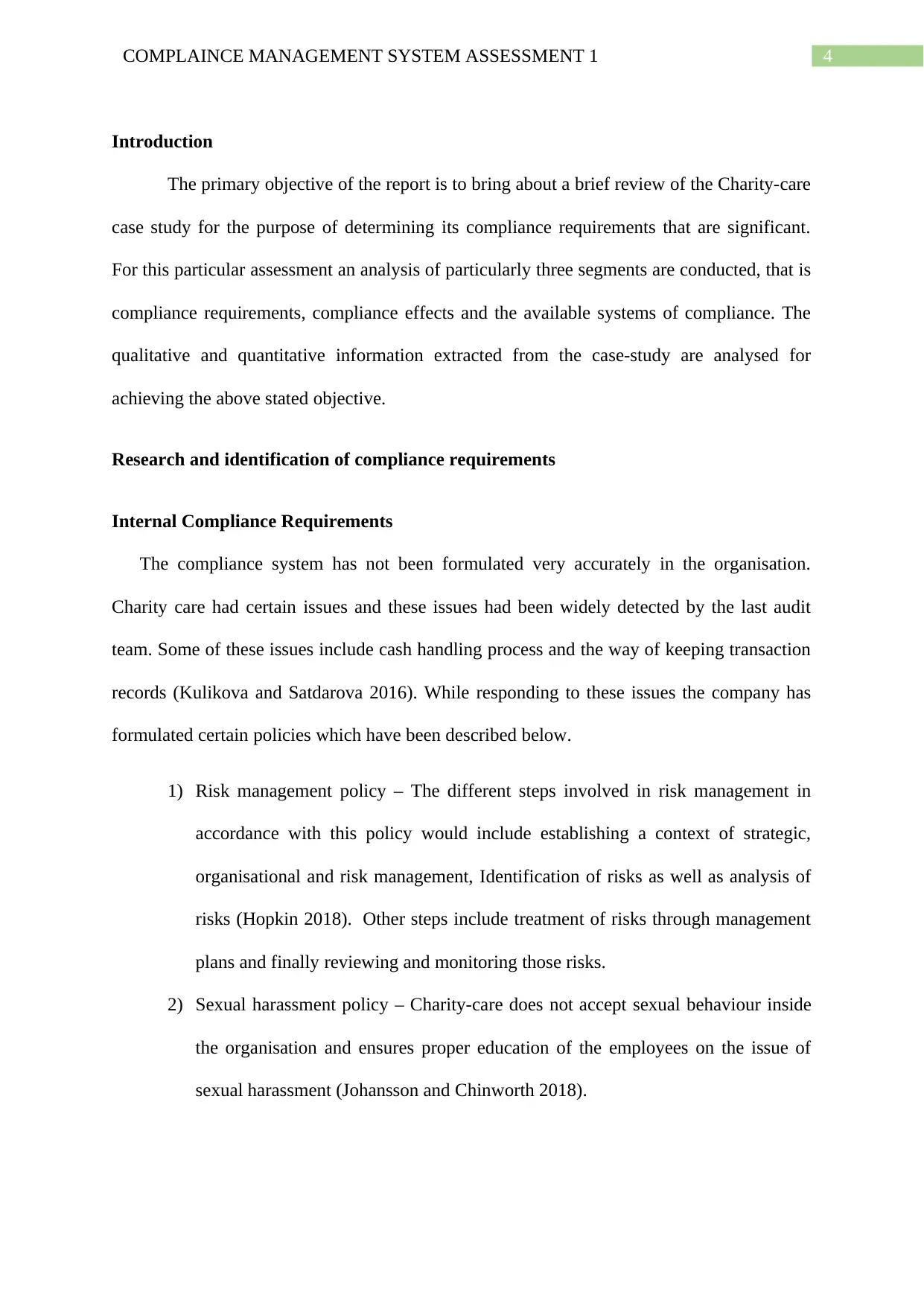
4COMPLAINCE MANAGEMENT SYSTEM ASSESSMENT 1
Introduction
The primary objective of the report is to bring about a brief review of the Charity-care
case study for the purpose of determining its compliance requirements that are significant.
For this particular assessment an analysis of particularly three segments are conducted, that is
compliance requirements, compliance effects and the available systems of compliance. The
qualitative and quantitative information extracted from the case-study are analysed for
achieving the above stated objective.
Research and identification of compliance requirements
Internal Compliance Requirements
The compliance system has not been formulated very accurately in the organisation.
Charity care had certain issues and these issues had been widely detected by the last audit
team. Some of these issues include cash handling process and the way of keeping transaction
records (Kulikova and Satdarova 2016). While responding to these issues the company has
formulated certain policies which have been described below.
1) Risk management policy – The different steps involved in risk management in
accordance with this policy would include establishing a context of strategic,
organisational and risk management, Identification of risks as well as analysis of
risks (Hopkin 2018). Other steps include treatment of risks through management
plans and finally reviewing and monitoring those risks.
2) Sexual harassment policy – Charity-care does not accept sexual behaviour inside
the organisation and ensures proper education of the employees on the issue of
sexual harassment (Johansson and Chinworth 2018).
Introduction
The primary objective of the report is to bring about a brief review of the Charity-care
case study for the purpose of determining its compliance requirements that are significant.
For this particular assessment an analysis of particularly three segments are conducted, that is
compliance requirements, compliance effects and the available systems of compliance. The
qualitative and quantitative information extracted from the case-study are analysed for
achieving the above stated objective.
Research and identification of compliance requirements
Internal Compliance Requirements
The compliance system has not been formulated very accurately in the organisation.
Charity care had certain issues and these issues had been widely detected by the last audit
team. Some of these issues include cash handling process and the way of keeping transaction
records (Kulikova and Satdarova 2016). While responding to these issues the company has
formulated certain policies which have been described below.
1) Risk management policy – The different steps involved in risk management in
accordance with this policy would include establishing a context of strategic,
organisational and risk management, Identification of risks as well as analysis of
risks (Hopkin 2018). Other steps include treatment of risks through management
plans and finally reviewing and monitoring those risks.
2) Sexual harassment policy – Charity-care does not accept sexual behaviour inside
the organisation and ensures proper education of the employees on the issue of
sexual harassment (Johansson and Chinworth 2018).
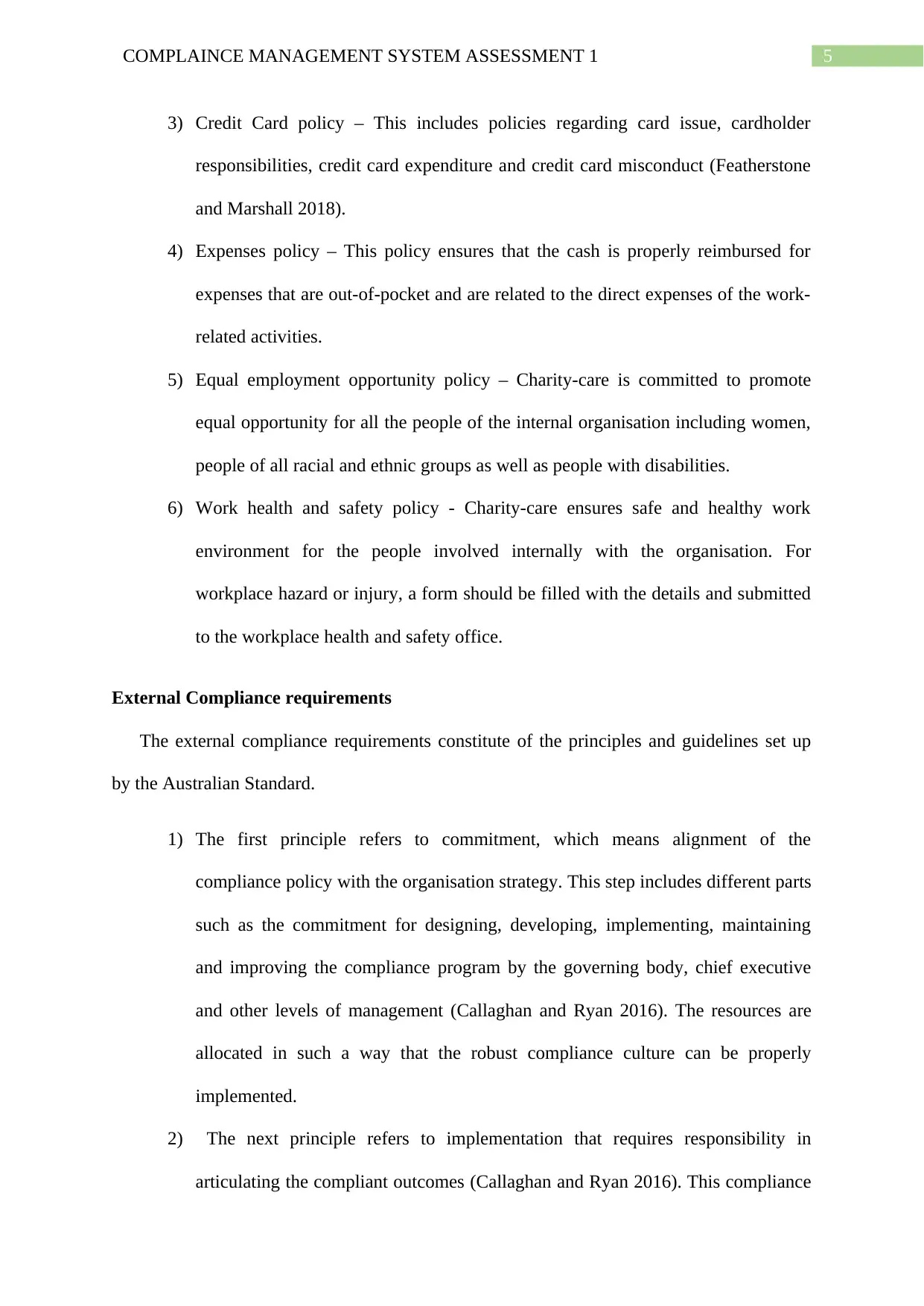
5COMPLAINCE MANAGEMENT SYSTEM ASSESSMENT 1
3) Credit Card policy – This includes policies regarding card issue, cardholder
responsibilities, credit card expenditure and credit card misconduct (Featherstone
and Marshall 2018).
4) Expenses policy – This policy ensures that the cash is properly reimbursed for
expenses that are out-of-pocket and are related to the direct expenses of the work-
related activities.
5) Equal employment opportunity policy – Charity-care is committed to promote
equal opportunity for all the people of the internal organisation including women,
people of all racial and ethnic groups as well as people with disabilities.
6) Work health and safety policy - Charity-care ensures safe and healthy work
environment for the people involved internally with the organisation. For
workplace hazard or injury, a form should be filled with the details and submitted
to the workplace health and safety office.
External Compliance requirements
The external compliance requirements constitute of the principles and guidelines set up
by the Australian Standard.
1) The first principle refers to commitment, which means alignment of the
compliance policy with the organisation strategy. This step includes different parts
such as the commitment for designing, developing, implementing, maintaining
and improving the compliance program by the governing body, chief executive
and other levels of management (Callaghan and Ryan 2016). The resources are
allocated in such a way that the robust compliance culture can be properly
implemented.
2) The next principle refers to implementation that requires responsibility in
articulating the compliant outcomes (Callaghan and Ryan 2016). This compliance
3) Credit Card policy – This includes policies regarding card issue, cardholder
responsibilities, credit card expenditure and credit card misconduct (Featherstone
and Marshall 2018).
4) Expenses policy – This policy ensures that the cash is properly reimbursed for
expenses that are out-of-pocket and are related to the direct expenses of the work-
related activities.
5) Equal employment opportunity policy – Charity-care is committed to promote
equal opportunity for all the people of the internal organisation including women,
people of all racial and ethnic groups as well as people with disabilities.
6) Work health and safety policy - Charity-care ensures safe and healthy work
environment for the people involved internally with the organisation. For
workplace hazard or injury, a form should be filled with the details and submitted
to the workplace health and safety office.
External Compliance requirements
The external compliance requirements constitute of the principles and guidelines set up
by the Australian Standard.
1) The first principle refers to commitment, which means alignment of the
compliance policy with the organisation strategy. This step includes different parts
such as the commitment for designing, developing, implementing, maintaining
and improving the compliance program by the governing body, chief executive
and other levels of management (Callaghan and Ryan 2016). The resources are
allocated in such a way that the robust compliance culture can be properly
implemented.
2) The next principle refers to implementation that requires responsibility in
articulating the compliant outcomes (Callaghan and Ryan 2016). This compliance
⊘ This is a preview!⊘
Do you want full access?
Subscribe today to unlock all pages.

Trusted by 1+ million students worldwide
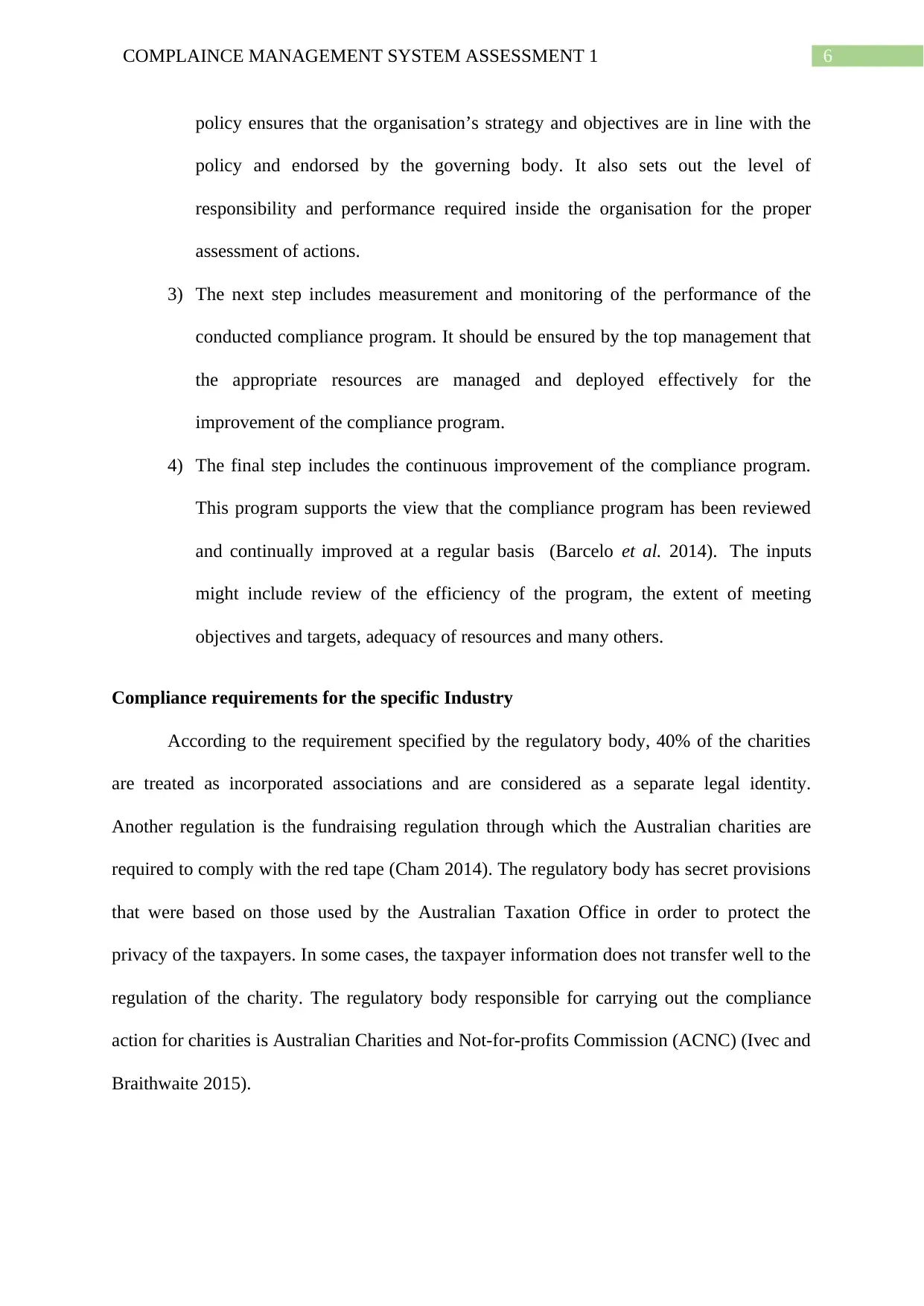
6COMPLAINCE MANAGEMENT SYSTEM ASSESSMENT 1
policy ensures that the organisation’s strategy and objectives are in line with the
policy and endorsed by the governing body. It also sets out the level of
responsibility and performance required inside the organisation for the proper
assessment of actions.
3) The next step includes measurement and monitoring of the performance of the
conducted compliance program. It should be ensured by the top management that
the appropriate resources are managed and deployed effectively for the
improvement of the compliance program.
4) The final step includes the continuous improvement of the compliance program.
This program supports the view that the compliance program has been reviewed
and continually improved at a regular basis (Barcelo et al. 2014). The inputs
might include review of the efficiency of the program, the extent of meeting
objectives and targets, adequacy of resources and many others.
Compliance requirements for the specific Industry
According to the requirement specified by the regulatory body, 40% of the charities
are treated as incorporated associations and are considered as a separate legal identity.
Another regulation is the fundraising regulation through which the Australian charities are
required to comply with the red tape (Cham 2014). The regulatory body has secret provisions
that were based on those used by the Australian Taxation Office in order to protect the
privacy of the taxpayers. In some cases, the taxpayer information does not transfer well to the
regulation of the charity. The regulatory body responsible for carrying out the compliance
action for charities is Australian Charities and Not-for-profits Commission (ACNC) (Ivec and
Braithwaite 2015).
policy ensures that the organisation’s strategy and objectives are in line with the
policy and endorsed by the governing body. It also sets out the level of
responsibility and performance required inside the organisation for the proper
assessment of actions.
3) The next step includes measurement and monitoring of the performance of the
conducted compliance program. It should be ensured by the top management that
the appropriate resources are managed and deployed effectively for the
improvement of the compliance program.
4) The final step includes the continuous improvement of the compliance program.
This program supports the view that the compliance program has been reviewed
and continually improved at a regular basis (Barcelo et al. 2014). The inputs
might include review of the efficiency of the program, the extent of meeting
objectives and targets, adequacy of resources and many others.
Compliance requirements for the specific Industry
According to the requirement specified by the regulatory body, 40% of the charities
are treated as incorporated associations and are considered as a separate legal identity.
Another regulation is the fundraising regulation through which the Australian charities are
required to comply with the red tape (Cham 2014). The regulatory body has secret provisions
that were based on those used by the Australian Taxation Office in order to protect the
privacy of the taxpayers. In some cases, the taxpayer information does not transfer well to the
regulation of the charity. The regulatory body responsible for carrying out the compliance
action for charities is Australian Charities and Not-for-profits Commission (ACNC) (Ivec and
Braithwaite 2015).
Paraphrase This Document
Need a fresh take? Get an instant paraphrase of this document with our AI Paraphraser
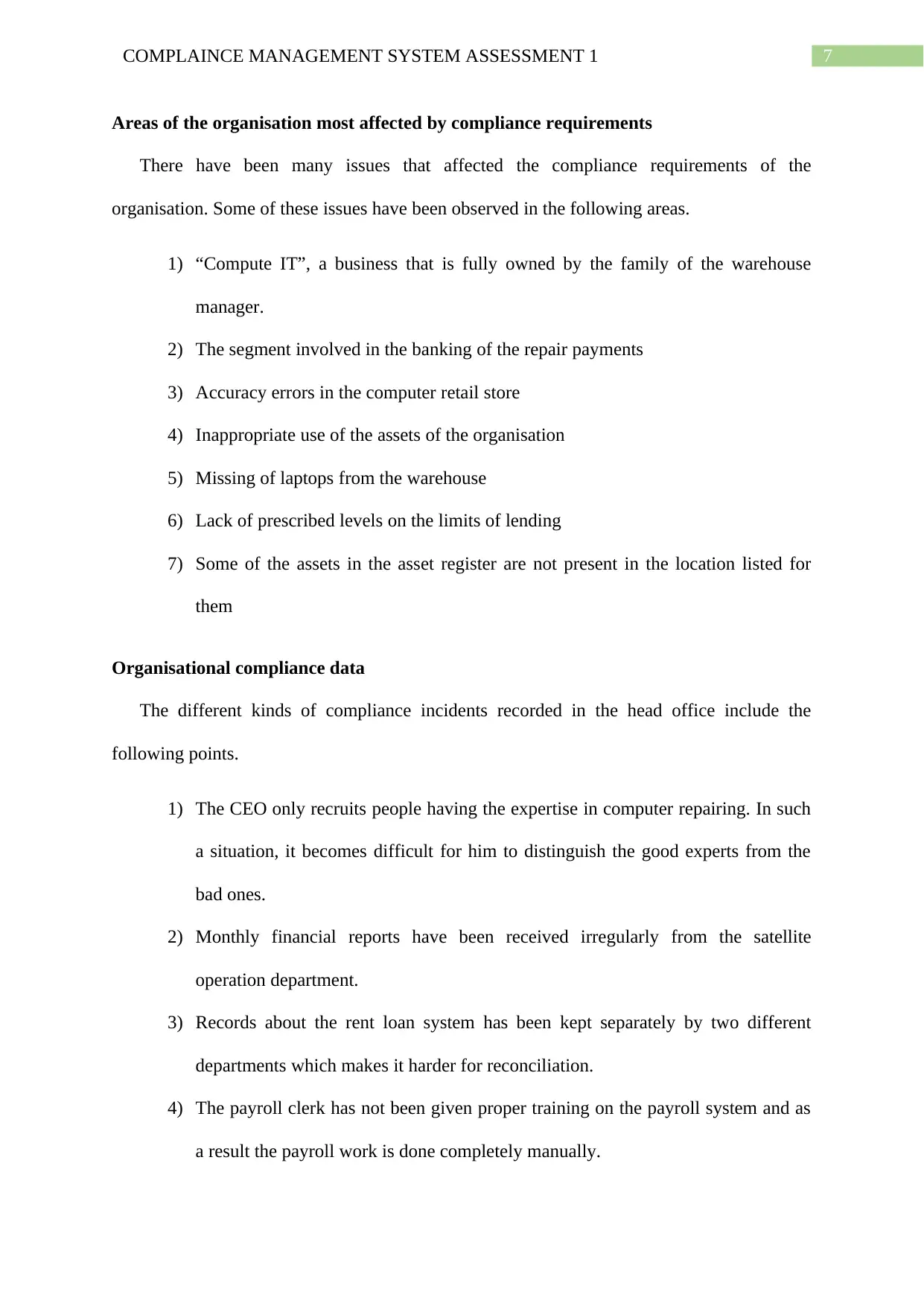
7COMPLAINCE MANAGEMENT SYSTEM ASSESSMENT 1
Areas of the organisation most affected by compliance requirements
There have been many issues that affected the compliance requirements of the
organisation. Some of these issues have been observed in the following areas.
1) “Compute IT”, a business that is fully owned by the family of the warehouse
manager.
2) The segment involved in the banking of the repair payments
3) Accuracy errors in the computer retail store
4) Inappropriate use of the assets of the organisation
5) Missing of laptops from the warehouse
6) Lack of prescribed levels on the limits of lending
7) Some of the assets in the asset register are not present in the location listed for
them
Organisational compliance data
The different kinds of compliance incidents recorded in the head office include the
following points.
1) The CEO only recruits people having the expertise in computer repairing. In such
a situation, it becomes difficult for him to distinguish the good experts from the
bad ones.
2) Monthly financial reports have been received irregularly from the satellite
operation department.
3) Records about the rent loan system has been kept separately by two different
departments which makes it harder for reconciliation.
4) The payroll clerk has not been given proper training on the payroll system and as
a result the payroll work is done completely manually.
Areas of the organisation most affected by compliance requirements
There have been many issues that affected the compliance requirements of the
organisation. Some of these issues have been observed in the following areas.
1) “Compute IT”, a business that is fully owned by the family of the warehouse
manager.
2) The segment involved in the banking of the repair payments
3) Accuracy errors in the computer retail store
4) Inappropriate use of the assets of the organisation
5) Missing of laptops from the warehouse
6) Lack of prescribed levels on the limits of lending
7) Some of the assets in the asset register are not present in the location listed for
them
Organisational compliance data
The different kinds of compliance incidents recorded in the head office include the
following points.
1) The CEO only recruits people having the expertise in computer repairing. In such
a situation, it becomes difficult for him to distinguish the good experts from the
bad ones.
2) Monthly financial reports have been received irregularly from the satellite
operation department.
3) Records about the rent loan system has been kept separately by two different
departments which makes it harder for reconciliation.
4) The payroll clerk has not been given proper training on the payroll system and as
a result the payroll work is done completely manually.
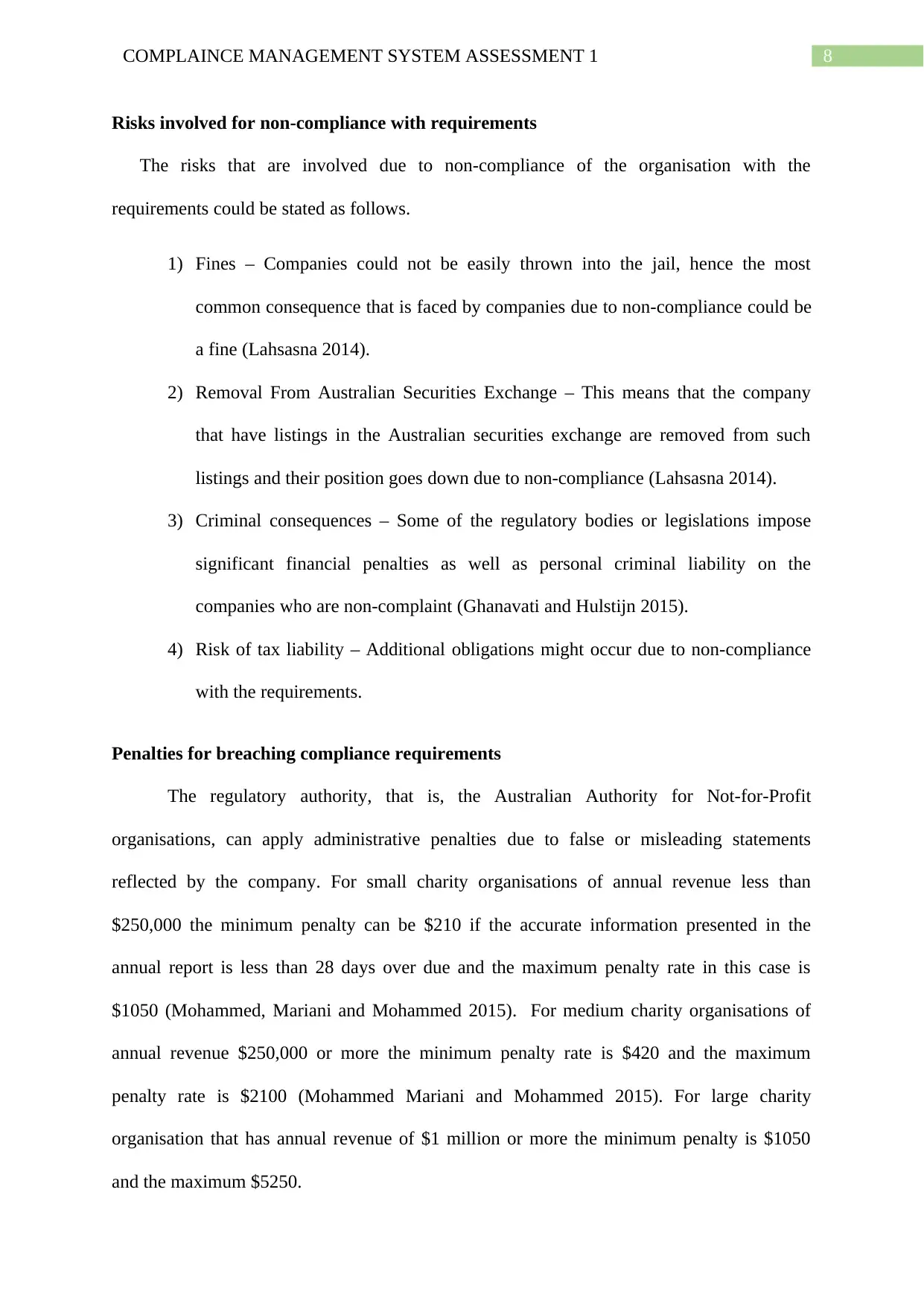
8COMPLAINCE MANAGEMENT SYSTEM ASSESSMENT 1
Risks involved for non-compliance with requirements
The risks that are involved due to non-compliance of the organisation with the
requirements could be stated as follows.
1) Fines – Companies could not be easily thrown into the jail, hence the most
common consequence that is faced by companies due to non-compliance could be
a fine (Lahsasna 2014).
2) Removal From Australian Securities Exchange – This means that the company
that have listings in the Australian securities exchange are removed from such
listings and their position goes down due to non-compliance (Lahsasna 2014).
3) Criminal consequences – Some of the regulatory bodies or legislations impose
significant financial penalties as well as personal criminal liability on the
companies who are non-complaint (Ghanavati and Hulstijn 2015).
4) Risk of tax liability – Additional obligations might occur due to non-compliance
with the requirements.
Penalties for breaching compliance requirements
The regulatory authority, that is, the Australian Authority for Not-for-Profit
organisations, can apply administrative penalties due to false or misleading statements
reflected by the company. For small charity organisations of annual revenue less than
$250,000 the minimum penalty can be $210 if the accurate information presented in the
annual report is less than 28 days over due and the maximum penalty rate in this case is
$1050 (Mohammed, Mariani and Mohammed 2015). For medium charity organisations of
annual revenue $250,000 or more the minimum penalty rate is $420 and the maximum
penalty rate is $2100 (Mohammed Mariani and Mohammed 2015). For large charity
organisation that has annual revenue of $1 million or more the minimum penalty is $1050
and the maximum $5250.
Risks involved for non-compliance with requirements
The risks that are involved due to non-compliance of the organisation with the
requirements could be stated as follows.
1) Fines – Companies could not be easily thrown into the jail, hence the most
common consequence that is faced by companies due to non-compliance could be
a fine (Lahsasna 2014).
2) Removal From Australian Securities Exchange – This means that the company
that have listings in the Australian securities exchange are removed from such
listings and their position goes down due to non-compliance (Lahsasna 2014).
3) Criminal consequences – Some of the regulatory bodies or legislations impose
significant financial penalties as well as personal criminal liability on the
companies who are non-complaint (Ghanavati and Hulstijn 2015).
4) Risk of tax liability – Additional obligations might occur due to non-compliance
with the requirements.
Penalties for breaching compliance requirements
The regulatory authority, that is, the Australian Authority for Not-for-Profit
organisations, can apply administrative penalties due to false or misleading statements
reflected by the company. For small charity organisations of annual revenue less than
$250,000 the minimum penalty can be $210 if the accurate information presented in the
annual report is less than 28 days over due and the maximum penalty rate in this case is
$1050 (Mohammed, Mariani and Mohammed 2015). For medium charity organisations of
annual revenue $250,000 or more the minimum penalty rate is $420 and the maximum
penalty rate is $2100 (Mohammed Mariani and Mohammed 2015). For large charity
organisation that has annual revenue of $1 million or more the minimum penalty is $1050
and the maximum $5250.
⊘ This is a preview!⊘
Do you want full access?
Subscribe today to unlock all pages.

Trusted by 1+ million students worldwide
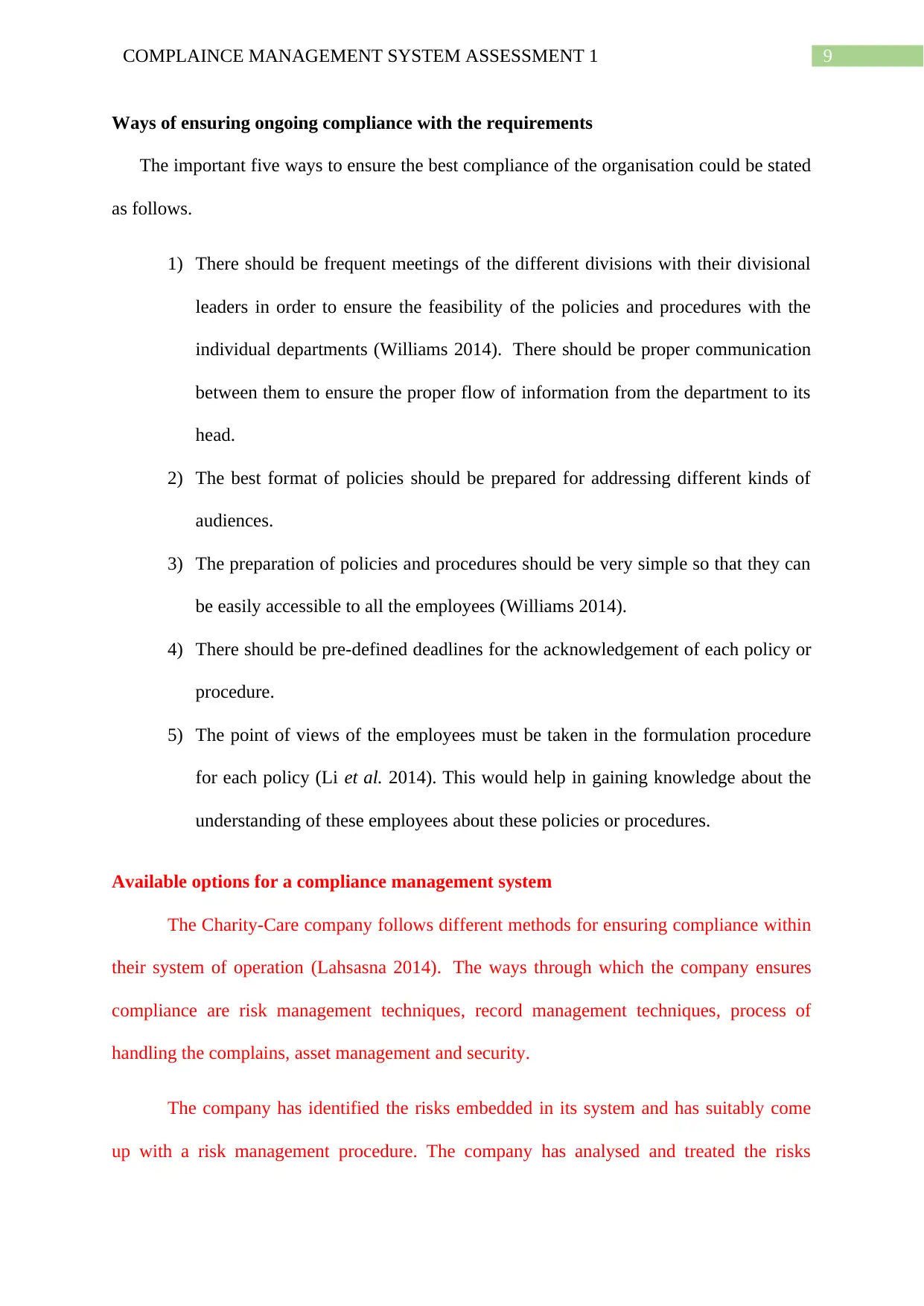
9COMPLAINCE MANAGEMENT SYSTEM ASSESSMENT 1
Ways of ensuring ongoing compliance with the requirements
The important five ways to ensure the best compliance of the organisation could be stated
as follows.
1) There should be frequent meetings of the different divisions with their divisional
leaders in order to ensure the feasibility of the policies and procedures with the
individual departments (Williams 2014). There should be proper communication
between them to ensure the proper flow of information from the department to its
head.
2) The best format of policies should be prepared for addressing different kinds of
audiences.
3) The preparation of policies and procedures should be very simple so that they can
be easily accessible to all the employees (Williams 2014).
4) There should be pre-defined deadlines for the acknowledgement of each policy or
procedure.
5) The point of views of the employees must be taken in the formulation procedure
for each policy (Li et al. 2014). This would help in gaining knowledge about the
understanding of these employees about these policies or procedures.
Available options for a compliance management system
The Charity-Care company follows different methods for ensuring compliance within
their system of operation (Lahsasna 2014). The ways through which the company ensures
compliance are risk management techniques, record management techniques, process of
handling the complains, asset management and security.
The company has identified the risks embedded in its system and has suitably come
up with a risk management procedure. The company has analysed and treated the risks
Ways of ensuring ongoing compliance with the requirements
The important five ways to ensure the best compliance of the organisation could be stated
as follows.
1) There should be frequent meetings of the different divisions with their divisional
leaders in order to ensure the feasibility of the policies and procedures with the
individual departments (Williams 2014). There should be proper communication
between them to ensure the proper flow of information from the department to its
head.
2) The best format of policies should be prepared for addressing different kinds of
audiences.
3) The preparation of policies and procedures should be very simple so that they can
be easily accessible to all the employees (Williams 2014).
4) There should be pre-defined deadlines for the acknowledgement of each policy or
procedure.
5) The point of views of the employees must be taken in the formulation procedure
for each policy (Li et al. 2014). This would help in gaining knowledge about the
understanding of these employees about these policies or procedures.
Available options for a compliance management system
The Charity-Care company follows different methods for ensuring compliance within
their system of operation (Lahsasna 2014). The ways through which the company ensures
compliance are risk management techniques, record management techniques, process of
handling the complains, asset management and security.
The company has identified the risks embedded in its system and has suitably come
up with a risk management procedure. The company has analysed and treated the risks
Paraphrase This Document
Need a fresh take? Get an instant paraphrase of this document with our AI Paraphraser
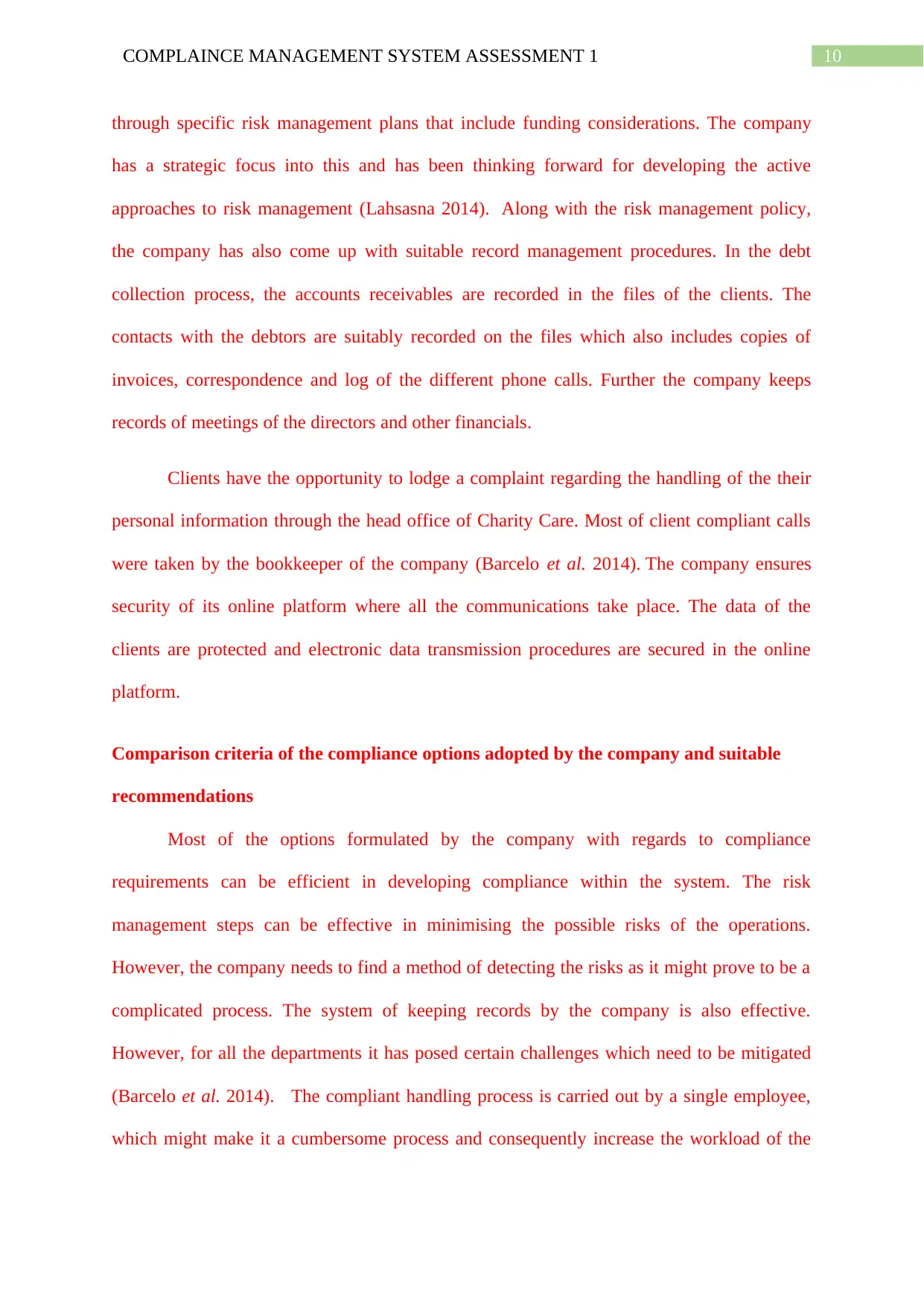
10COMPLAINCE MANAGEMENT SYSTEM ASSESSMENT 1
through specific risk management plans that include funding considerations. The company
has a strategic focus into this and has been thinking forward for developing the active
approaches to risk management (Lahsasna 2014). Along with the risk management policy,
the company has also come up with suitable record management procedures. In the debt
collection process, the accounts receivables are recorded in the files of the clients. The
contacts with the debtors are suitably recorded on the files which also includes copies of
invoices, correspondence and log of the different phone calls. Further the company keeps
records of meetings of the directors and other financials.
Clients have the opportunity to lodge a complaint regarding the handling of the their
personal information through the head office of Charity Care. Most of client compliant calls
were taken by the bookkeeper of the company (Barcelo et al. 2014). The company ensures
security of its online platform where all the communications take place. The data of the
clients are protected and electronic data transmission procedures are secured in the online
platform.
Comparison criteria of the compliance options adopted by the company and suitable
recommendations
Most of the options formulated by the company with regards to compliance
requirements can be efficient in developing compliance within the system. The risk
management steps can be effective in minimising the possible risks of the operations.
However, the company needs to find a method of detecting the risks as it might prove to be a
complicated process. The system of keeping records by the company is also effective.
However, for all the departments it has posed certain challenges which need to be mitigated
(Barcelo et al. 2014). The compliant handling process is carried out by a single employee,
which might make it a cumbersome process and consequently increase the workload of the
through specific risk management plans that include funding considerations. The company
has a strategic focus into this and has been thinking forward for developing the active
approaches to risk management (Lahsasna 2014). Along with the risk management policy,
the company has also come up with suitable record management procedures. In the debt
collection process, the accounts receivables are recorded in the files of the clients. The
contacts with the debtors are suitably recorded on the files which also includes copies of
invoices, correspondence and log of the different phone calls. Further the company keeps
records of meetings of the directors and other financials.
Clients have the opportunity to lodge a complaint regarding the handling of the their
personal information through the head office of Charity Care. Most of client compliant calls
were taken by the bookkeeper of the company (Barcelo et al. 2014). The company ensures
security of its online platform where all the communications take place. The data of the
clients are protected and electronic data transmission procedures are secured in the online
platform.
Comparison criteria of the compliance options adopted by the company and suitable
recommendations
Most of the options formulated by the company with regards to compliance
requirements can be efficient in developing compliance within the system. The risk
management steps can be effective in minimising the possible risks of the operations.
However, the company needs to find a method of detecting the risks as it might prove to be a
complicated process. The system of keeping records by the company is also effective.
However, for all the departments it has posed certain challenges which need to be mitigated
(Barcelo et al. 2014). The compliant handling process is carried out by a single employee,
which might make it a cumbersome process and consequently increase the workload of the
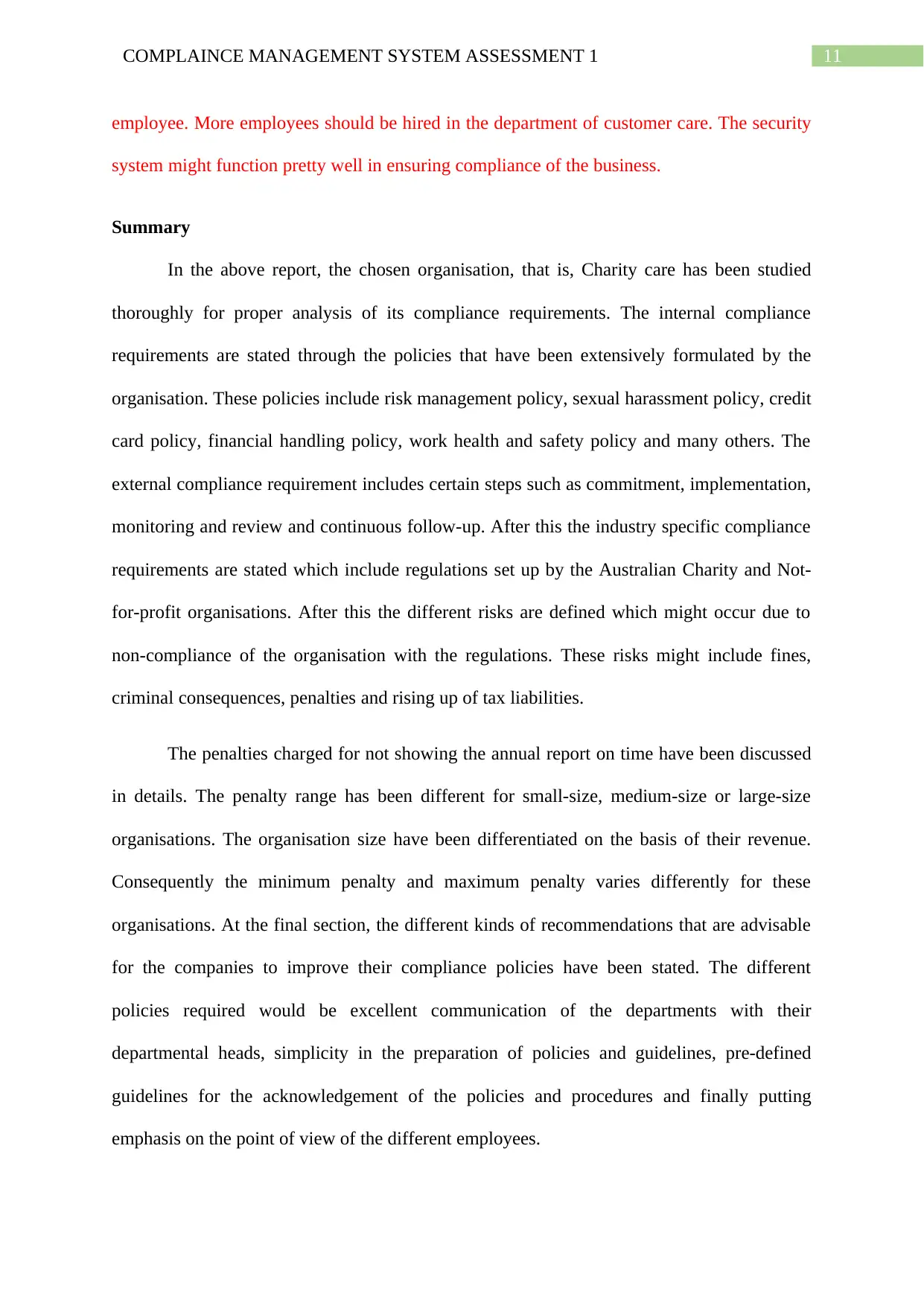
11COMPLAINCE MANAGEMENT SYSTEM ASSESSMENT 1
employee. More employees should be hired in the department of customer care. The security
system might function pretty well in ensuring compliance of the business.
Summary
In the above report, the chosen organisation, that is, Charity care has been studied
thoroughly for proper analysis of its compliance requirements. The internal compliance
requirements are stated through the policies that have been extensively formulated by the
organisation. These policies include risk management policy, sexual harassment policy, credit
card policy, financial handling policy, work health and safety policy and many others. The
external compliance requirement includes certain steps such as commitment, implementation,
monitoring and review and continuous follow-up. After this the industry specific compliance
requirements are stated which include regulations set up by the Australian Charity and Not-
for-profit organisations. After this the different risks are defined which might occur due to
non-compliance of the organisation with the regulations. These risks might include fines,
criminal consequences, penalties and rising up of tax liabilities.
The penalties charged for not showing the annual report on time have been discussed
in details. The penalty range has been different for small-size, medium-size or large-size
organisations. The organisation size have been differentiated on the basis of their revenue.
Consequently the minimum penalty and maximum penalty varies differently for these
organisations. At the final section, the different kinds of recommendations that are advisable
for the companies to improve their compliance policies have been stated. The different
policies required would be excellent communication of the departments with their
departmental heads, simplicity in the preparation of policies and guidelines, pre-defined
guidelines for the acknowledgement of the policies and procedures and finally putting
emphasis on the point of view of the different employees.
employee. More employees should be hired in the department of customer care. The security
system might function pretty well in ensuring compliance of the business.
Summary
In the above report, the chosen organisation, that is, Charity care has been studied
thoroughly for proper analysis of its compliance requirements. The internal compliance
requirements are stated through the policies that have been extensively formulated by the
organisation. These policies include risk management policy, sexual harassment policy, credit
card policy, financial handling policy, work health and safety policy and many others. The
external compliance requirement includes certain steps such as commitment, implementation,
monitoring and review and continuous follow-up. After this the industry specific compliance
requirements are stated which include regulations set up by the Australian Charity and Not-
for-profit organisations. After this the different risks are defined which might occur due to
non-compliance of the organisation with the regulations. These risks might include fines,
criminal consequences, penalties and rising up of tax liabilities.
The penalties charged for not showing the annual report on time have been discussed
in details. The penalty range has been different for small-size, medium-size or large-size
organisations. The organisation size have been differentiated on the basis of their revenue.
Consequently the minimum penalty and maximum penalty varies differently for these
organisations. At the final section, the different kinds of recommendations that are advisable
for the companies to improve their compliance policies have been stated. The different
policies required would be excellent communication of the departments with their
departmental heads, simplicity in the preparation of policies and guidelines, pre-defined
guidelines for the acknowledgement of the policies and procedures and finally putting
emphasis on the point of view of the different employees.
⊘ This is a preview!⊘
Do you want full access?
Subscribe today to unlock all pages.

Trusted by 1+ million students worldwide
1 out of 18
Related Documents
Your All-in-One AI-Powered Toolkit for Academic Success.
+13062052269
info@desklib.com
Available 24*7 on WhatsApp / Email
![[object Object]](/_next/static/media/star-bottom.7253800d.svg)
Unlock your academic potential
Copyright © 2020–2025 A2Z Services. All Rights Reserved. Developed and managed by ZUCOL.





